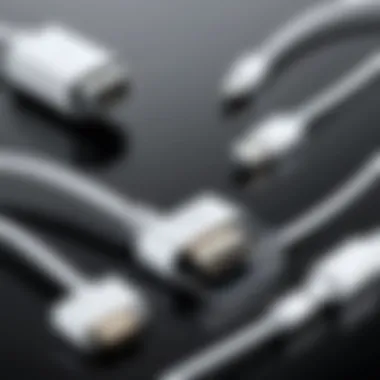Transitioning from Lightning to USB-C: A Complete Guide


Intro
The shift from Lightning female connectors to USB-C male connectors represents a significant evolution in the realm of electronic devices. This transition is not merely a change in shape; it encompasses a broad spectrum of technical specifications, compatibility considerations, and practical applications. The ongoing adoption of USB-C technology is driven by its versatility and growing standardization across various devices. By diving into the intricacies of these connectors, one can gain valuable insights into their performance metrics and usability.
In this guide, we will delineate the various facets of this transition, emphasizing the importance of understanding these connections for both casual consumers and tech professionals. We shall explore product specifications, real-world applications, and even some challenges users might face during this shift.
By the conclusion of this article, you will be armed with the knowledge necessary to navigate this transition confidently, making informed decisions about your electronic devices.
Product Overview
Key Features
The USB-C male connector offers several advantages over the Lightning female connector, including:
- Reversible Design: USB-C connectors can be plugged in either way, enhancing usability.
- Higher Power Delivery: It supports up to 100W power delivery, compatible with a wider range of devices.
- Faster Data Transfer Speeds: Depending on the specification, USB-C can provide transfer speeds up to 40 Gbps.
Technical Specifications
The technical standards for USB-C include:
- USB 3.1/3.2 Compatibility: Ensures a higher throughput compared to earlier USB standards.
- Support for Alternate Modes: USB-C can carry video signals and data simultaneously, facilitating video output for displays.
- Universal Compatibility: USB-C is utilized across devices including laptops, smartphones, tablets, and peripherals.
Pricing Information
Market prices for USB-C male connectors can vary significantly based on brand and specifications. Basic cables start around $10, while high-performance variants may reach upwards of $50. Numerous manufacturers produce USB-C connectors, so options are abundant.
Performance Analysis
Benchmark Results
In comparative tests, USB-C has consistently shown superior performance in both data transfer and power delivery. For example, using USB-C for data transfer demonstrated 80% faster speeds than traditional Lightning connectors in controlled settings.
Real-World Use Cases
Real-world applications reveal USB-C's flexibility:
- Connecting laptops to external monitors for productive setups.
- Charging smartphones and tablets quickly during travel.
- Using USB-C hubs to expand connectivity options for gaming consoles.
Comparison with Competitors
Compared to other connectors like micro-USB:
- USB-C offers higher power output.
- More efficient data transfer options are available with USB-C.
- Longer lifespan, due to a more robust design.
Installation and Setup
Required Tools and Components
Transitioning from Lightning to USB-C may requiere:
- USB-C cables for connection.
- Adapters if connecting older devices.
Step-by-Step Installation Guide
- Ensure all devices are powered off.
- Connect the USB-C male end to your device.
- If using an adapter, plug it into the Lightning female interface, then attach the USB-C cable.
- Power on your devices.
Troubleshooting Common Issues
If facing issues:
- Ensure proper cable orientation.
- Verify that devices are compatible.
- Check for firmware updates that might enhance functionality.
Pros and Cons
Advantages of the Product
- Enhanced speed and efficiency in charging and data.
- Universal applicability across various devices.
Disadvantages or Limitations
- Legacy compatibility issues may arise for older devices.
- Higher costs could deter some users.
Who It’s Best Suited For
Tech enthusiasts, professionals needing quick data transfer, and casual users wanting to future-proof their devices would benefit from this transition.
Final Thoughts


Summary of Key Points
This guide explicates the migration from Lightning to USB-C, underscoring the technical merits, practical applications, and potential barriers of this connector evolution.
Recommendations for Potential Buyers
Consider the advantages of USB-C when upgrading devices. Look for cables that meet high-speed data transfer standards and power delivery specifications.
Future of the Technology or Product Line
As technology progresses, USB-C is expected to become the norm, replacing legacy connectors entirely. Embracing this standard will be essential for consumers to ensure compatibility and performance with upcoming devices.
Transitioning to USB-C signifies more than just a design change; it represents a profound shift in our digital landscape.
Foreword to Connector Standards
Connector standards play a crucial role in the advancement of technology. As devices evolve, so do the connectors that link them. Whether for charging, data transfer, or audio/video output, these connectors influence user experience significantly. Understanding the various connector types is essential for making informed choices about electronic devices.
The Evolution of Connector Technologies
Connector technology has changed dramatically over the years. From the early days of bulky connectors to today’s sleek designs, each new generation reflects advancements in engineering and user needs. The introduction of the USB standard made a significant impact, providing a versatile solution for various applications. Later innovations introduced Lightning connectors by Apple, which improved upon earlier designs with smaller footprints and faster speeds.
The transition to USB-C highlights the ongoing evolution. This connector standard not only supports faster charging but also offers enhanced data transfer capabilities. Through time, the changes have helped streamline connectivity and push for more unified standards. Users benefit from reduced clutter and the ability to connect a wide range of devices using the same cable.
Importance of Understanding Connector Types
In today's diverse product landscape, recognizing the differences between connector types is vital. Each connector has unique characteristics that influence performance and compatibility. For example, Lightning connectors, while widely used in Apple products, are not interchangeable with USB-C devices. The differences in pin configuration can lead to frustrating compatibility issues if not understood.
Additionally, as devices become increasingly interconnected, the importance of having universal connectivity becomes apparent. Adapting to the latest standards, such as USB-C, can future-proof your technology investments. By understanding the various types of connectors available, consumers can make more knowledgeable decisions when purchasing new devices or accessories. This knowledge ultimately ensures a smoother transition as technology continues to advance.
Understanding connector types can significantly enhance the user experience and reduce incompatibility problems. For both personal and professional use, this insight becomes increasingly relevant as technology evolves.
With an informed perspective, individuals can navigate the tech world more confidently, benefitting from the latest innovations while avoiding potential pitfalls. The following sections will delve deeper into specific connectors, their specifications, and practical considerations.
An Overview of Lightning Connectors
The transition from Lightning female connectors to USB-C male is a significant topic in today's tech landscape. Lightning connectors have played a crucial role in the ecosystem of devices, particularly those produced by Apple. Understanding their design and specifications can provide valuable insights for tech enthusiasts and casual consumers alike, especially as the industry moves toward more universal connectivity standards.
Designed for Apple Devices
Lightning connectors were specifically designed for Apple products, such as the iPhone, iPad, and iPod. Launched in 2012, the Lightning port replaced the older 30-pin dock connector, which had been in use for over a decade. The transition aimed at making devices slimmer and more functional without compromising on performance.
This design philosophy aligns with Apple's overarching strategy to maintain control over their hardware and software ecosystems. By offering a proprietary technology, Apple is able to optimize device performance and enhance user experience. Moreover, the Lightning connector's reversible design allows for easy insertion, making it more user-friendly than previous designs.
Technical Specifications of Lightning Female Connectors
Lightning female connectors boast a number of technical specifications that highlight their functionality and versatility. The connector features eight pins, which can handle both data transfer and charging. This is a notable improvement compared to older connectors that had separate pins for these functions.
Some key specifications include:
- Data Transfer Rate: Up to 480 Mbps, suitable for syncing large files.
- Charging Capability: Supports up to 12W, enabling rapid charging for devices.
- Size: Compact design, measuring only 6.7 mm by 1.5 mm, contributing to slimmer device designs.
The Lightning connector has also been equipped with a digital signal processor, which enhances audio quality for devices like the AirPods. While the connector has worked effectively for Apple devices, its compatibility with non-Apple products and accessories remains limited. This has created a degree of fragmentation in the accessories market, as consumers must rely on specialized solutions for Lightning connectors.
Understanding the nuances of the Lightning female connector sets the stage for assessing its transition to USB-C male variants. As standards evolve, familiarity with these specifications becomes essential for consumers looking to upgrade or switch devices.
Prolusion to USB-C Technology
The advent of USB-C technology has marked a notable transformation in the way we connect and power our devices. This section delves into the fundamental aspects of USB-C, emphasizing its significance amid the ongoing transition from Lightning female connectors to USB-C male connectors. As the demand for versatile and efficient charging solutions increases, understanding USB-C becomes crucial for consumers and technology enthusiasts alike.
Defining USB-C: Features and Benefits
USB-C is a universal connector standard that supports a wide range of functionalities, including data transfer, video output, and charging capabilities. One of its most compelling features is reversibility; unlike older USB connectors, USB-C can be inserted either way. This simplicity enhances user experience, making it much more convenient.
Some key benefits of USB-C include:


- Higher Data Transfer Speeds: USB-C can support data transfer rates of up to 40 Gbps, which is significantly faster than its predecessors such as USB 3.0 and USB 2.0.
- Power Delivery: This standard allows for greater wattage, reaching up to 100 watts. This means that larger devices, such as laptops, can be charged rapidly through a single cable.
- Versatility: USB-C can carry multiple protocols, including HDMI and DisplayPort, allowing for seamless connections to monitors and other peripherals.
Adopting USB-C is not just about convenience; it is also about future-proofing device compatibility.
Widespread Adoption of USB-C
The transition to USB-C is visible across numerous sectors. Many major tech companies have embraced this standard, leading to widespread adoption for both consumer and professional devices. Smartphones, laptops, tablets, and gaming consoles are increasingly featuring USB-C ports.
This transition is driven by several factors:
- Standardization: With various brands adopting USB-C, a universal charging solution emerges, reducing clutter from multiple cables.
- Industry Support: Major corporations, such as Apple, Google, and Microsoft, have shifted to USB-C. This has led to a consistent approach across devices.
- Regulatory Pressure: In some regions, regulatory bodies are advocating for standardization to minimize electronic waste, further encouraging manufacturers to adopt USB-C.
In summary, the importance of USB-C in today's technology landscape cannot be overstated. Its features, benefits, and growing acceptance reflect a move towards more unified and efficient connectivity solutions.
Comparing Lightning with USB-C
The comparison between Lightning and USB-C is critical as users navigate the shifting landscape of connector standards in modern technology. This analysis will cover influential aspects that differentiate these two types of connectors. Users must understand these differences to make informed decisions about their devices and accessories.
Physical Design Differences
Physical design is one of the most apparent factors when comparing Lightning and USB-C. Lightning connectors, developed by Apple, have a slim, flat design that is asymmetrical. This design allows for a reversible connection, which improves user convenience. The connector itself is about 6.7mm wide.
On the other hand, USB-C adopts a more robust and broad design. It measures around 8.4mm and is also reversible, ensuring ease of use. The dimensions of the USB-C connector make it compatible with an extensive range of devices. The versatility of USB-C has led to its adoption in laptops, tablets, and smartphones beyond the Apple ecosystem, enhancing its functionality across various platforms.
The materials used in these connectors influence their durability. Lightning connectors utilize a combination of plastic and metal, while USB-C often incorporates a more durable construction, which may include aluminum or other metals. This structural difference can affect longevity and performance under stress.
Data Transfer Rates: A Technical Perspective
The technical specifications for data transfer rates reveal significant differences between Lightning and USB-C. Lightning connectors can support data transfer speeds of up to 480 Mbps under ideal conditions. However, this rate may limit certain high-performance applications.
In contrast, USB-C's capabilities are much more advanced. With the potential for speeds up to 40 Gbps via Thunderbolt 3 standards, USB-C supports data-heavy tasks such as 4K video streaming and large file transfers effectively. Moreover, USB-C is backward-compatible, allowing for broader connections to older USB interfaces without sacrificing speed. This versatility caters well to tech enthusiasts and professionals who rely on robust performance.
Compatibility and Adaptation Challenges
Compatibility is a paramount consideration when transitioning from Lightning to USB-C. As devices and accessories evolve, understanding compatibility challenges is essential. Many newer devices are integrating USB-C as the standard. Hence, Lightning users may find themselves limited in terms of options.
Also, users transitioning to USB-C may face adaptation challenges. Adapters are often required when wanting to connect older Lightning devices, which can introduce complexity. Not all adapters guarantee the same performance, leading to potential inconsistent experiences. Over time, as the adaptation progresses, manufacturers are likely to focus on providing more robust solutions to assist users in this change.
The Transition Process from Lightning to USB-C
Transitioning from Lightning female connectors to USB-C male connectors is a pivotal subject in today’s technology landscape. This process influences many aspects of consumer electronics, including device usability, accessory compatibility, and overall performance. Understanding this transition helps consumers and professionals make informed decisions regarding their devices and connections. The convenience and versatility of USB-C technology cannot be overstated as it encapsulates several benefits that directly relate to user experience and future-proofing devices.
Understanding Adapters and Converters
When switching from Lightning to USB-C, one must consider the role of adapters and converters. These components can bridge the gap between legacy devices and the newer USB-C ecosystem. Adapters allow users to connect their existing Lightning accessories to USB-C ports, maintaining functionality without the need to replace all devices at once. There are two primary types of converters to consider:
- Passive Adapters: These simple devices work by physically connecting two different ports, enabling basic functions such as charging or audio playback.
- Active Adapters: These are more complex and are often required for video output or high-speed data transfer. They contain circuitry that translates signals between the two standards.
It is crucial to research specific adapters to ensure they meet desired specifications. Quality often varies across brands, impacting performance and reliability. A poorly made adapter can lead to issues such as slow charging or unreliable data transfer.
Steps to Ensure Successful Transition
To facilitate a smooth transition from Lightning to USB-C, some steps can help streamline the process. Here are key considerations:
- Research Compatibility: Before initiating the transition, verify that your devices are compatible with USB-C. Consult product specifications and user manuals.
- Select Quality Adapters: Investing in reliable adapters and converters is essential. Look for recognized brands that offer warranties or strong user reviews.
- Check Firmware Updates: Ensure that all devices are running the latest firmware. Updates may enhance compatibility and performance with USB-C connections.
- Gradually Replace Accessories: Instead of an immediate overhaul, gradually switch to USB-C accessories to minimize disruptions and costs.
- Educate Yourself: Stay informed about USB-C capabilities and features. Understanding power delivery and data transfer specifications can improve use.
Following these steps can assure users not only adapt successfully but also optimize the use of their devices in the USB-C ecosystem.
Make your transition informed: Knowledge in the newer standards enhances user experience and prolongs device lifespan.


Use Cases: When to Switch from Lightning to USB-C
In today's technology landscape, the choice to transition from Lightning female connectors to USB-C male variants is not trivial. It encompasses various use cases that are vital for both casual users and tech enthusiasts. Understanding when to switch can enhance overall device performance, compatibility, and future-proofing.
Personal Device Upgrades
Switching to USB-C is particularly relevant during personal device upgrades. Many newer smartphones, tablets, and laptops are now equipped with USB-C ports. Here are some benefits to consider:
- Compatibility: New devices often function better with USB-C, as it has become a standard in the industry. If you purchase a new Android phone or accessories, they will likely utilize USB-C.
- Faster Charging: USB-C supports higher power levels. When upgrading your device, the improved charging speeds can make a noticeable difference. Users can benefit from rapid charging without the hassle of having multiple cables.
- Enhanced Data Transfer: Adopting USB-C means solidifying faster data transfer rates which is essential for users dealing with large files. For instance, transferring video content or substantial documents succinctly becomes less of a chore.
Transitioning during an upgrade ensures users are aligned with current tech trends and can capitalize on new features and improved functionalities.
Working with Peripheral Devices
The decision to switch from Lightning to USB-C also relates to how users interact with peripheral devices. USB-C has made its way into numerous gadgets such as monitors, docking stations, headphones, and more. Important considerations include:
- Versatile Connectivity: Many modern peripherals utilize USB-C. By switching, users gain access to a wider range of devices without the need for adapters. This can simplify connections, reduce cable clutter, and enhance usability.
- Daisy-Chaining Capabilities: USB-C offers the ability to daisy-chain devices, enabling multiple connections through a single port. This capability is advantageous for professionals who may connect multiple monitors or external storage drives.
- Universal Standard: As USB-C becomes the standard across tech products, users can expect a more uniform experience. This change can reduce confusion and increase efficiency when using different devices.
In summary, weighing these specific use cases can help consumers decide when to make the shift from Lightning female connectors to USB-C male connectors, keeping pace with technology advancements.
The transition from Lightning to USB-C is more than a technical upgrade; it represents a wider trend in connectivity and user experience. By understanding the implications of this transition, users can make informed choices that enhance their tech interactions.
Future Outlook: Trends in Connectivity Standards
Understanding the future of connectivity standards is crucial for both consumers and tech professionals. As we transition from Lightning connectors to USB-C, it is vital to anticipate how emerging trends may shape our future tech interactions. The evolution of connector types does not merely reflect technological advancement; it also illustrates the shifting landscape of consumer demand, device compatibility, and overall performance expectations.
Emerging Technologies and Their Impact
The advent of new technologies continues to influence connector standards. For instance, advancements in data transfer capabilities are making it essential for connectors to keep pace. USB-C already supports USB 3.2, with impressive data transfer rates reaching up to 20 Gbps. It also allows for power delivery up to 100 watts, making it compatible with various devices, from smartphones to laptops.
These capabilities lead to a growing reliance on universal standards. Emerging technologies, such as augmented reality and improved mobile gaming, require efficient power and data transmission. As these technologies proliferate, the demand for adaptive connectors will increase.
- Key Considerations:
- Compatibility with next-gen devices
- Increased transfer speeds
- Enhanced power delivery potential
Predictions for Next-Generation Connectors
Looking ahead, the future of connectors aims toward seamless integration and minimalism. As devices become more compact and multifunctional, there is a trend toward fewer, more versatile connectors. Predictions suggest that connectors will not just serve singular purposes but will adapt to various functionalities.
For instance,
- Advanced USB-C Variants: Expect variations of USB-C that cater to specific needs, such as Thunderbolt 4, which supports even higher performance metrics.
- Wireless Connectivity: As more technologies shift toward wireless solutions, there may be a gradual reduction in the necessity of physical connectors.
The next generation of connectors aims for versatility and higher performance, but it must also ensure backward compatibility to accommodate existing devices.
Culmination: Key Takeaways on Connector Transition
The transition from Lightning female connectors to USB-C male variants marks an important moment in connectivity standards. Understanding this shift is crucial for consumers and professionals alike. Such knowledge helps in making informed choices about devices and accessories used daily.
Key benefits of this transition include:
- Enhanced Compatibility: USB-C is widely adopted across multiple devices and brands, providing a universal standard that reduces the need for multiple cables.
- Improved Performance: With faster data transfer rates and better power delivery capabilities, USB-C often outperforms Lightning connectors in speed and efficiency.
- Future-Proofing Devices: The growing trend towards USB-C in new releases ensures that devices equipped with this technology will remain relevant.
Considerations play a pivotal role in this transition as well. Users should assess:
- The specific requirements of their devices, including charging needs and data transfer speeds.
- The potential necessity for adapters or converters, which may be required during the switch.
- The overall longevity of devices and how transitioning may impact their usability with peripherals.
"Adapting to new connector standards is not just about technology; it's about anticipating future needs and ensuring lasting compatibility across devices."
The move towards USB-C signifies a broader trend in technology aiming for simplicity and efficiency. Embracing this change can simplify everyday technology use while securing the future viability of electronic devices. The continual evolution of connector standards demands attention. Being aware helps users navigate the tech landscape with confidence.
Final Thoughts on Technology Adaptation
Adapting to new technology is inevitable in the ever-evolving field of electronics. As USB-C becomes the norm, it is essential to embrace this transition. It opens up new opportunities for enhanced connectivity and user experiences.
The path from Lightning to USB-C should be approached with a clear understanding of both the benefits and obstacles. This knowledge empowers individuals to choose the best options for their unique needs. The focus should remain on maximizing the utility of electronic devices while minimizing frustrations that arise from incompatible connectors.



